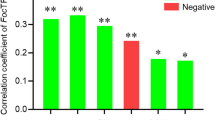Abstract
We identified 108 Gram-positive bacterial strains isolated from the root surface of wheat grown under different soil conditions. The strains were divided into four groups based on morphological and physiological characteristics, but most appeared to be coryneform. The taxonomic position of the various groups was verified by the guanine+cytosine DNA contents of the strains. In general, the ranges of these values agreed with those described for the respective taxonomic positions in the literature, with a few exceptions. With soil improvement the distribution of the various groups on the root surface changed, with the coryneform group becoming dominant. This group was further divided into five subgroups, according to cell wall components, cellulose-decomposition, and morphological characteristics, and were identified to genus level. The distribution of these subgroups on the root surface of wheat did not alter with soil improvement. The genus Arthrobacter, the dominant subgroup, predominated in every plot.
Similar content being viewed by others
References
Alexander M (1977) Introduction to soil microbiology, 2nd edn. Wiley, New York
Curl EA, Truelove B (1986) The rhizosphere. Springer-Verlag, Berlin Heidelberg New York Tokyo
Goodfellow M, Williams ST (1983) Ecology of actinomycetes. Annu Rev Microbiol 37:189–216
Jiang HY, Sato K (1992) Fluctuations in bacterial populations on the root surface of wheat (Triticum aestivum L) grown under different soil conditions. Biol Fertil Soils 14:246–252
Jiang HY, Sato K (1994) Interrelationships between bacterial populations on the root surface of wheat and growth of plants. Soil Sci Plant Nutr 40:683–689
Kloepper JW, Scher FM, Laliberte M, Zaleska I (1985) Measuring the spermatosphere colonizing capacity (spermatosphere competence) of bacterial inoculants. Can J Microbiol 31:926–929
Lorch H-J, Benckiser G, Ottow JCG (1995) Basic methods for counting microorganisms in soil and water. In: Alef K, Nannipieri P (eds) Methods in applied soil microbiology and biochemistry. Academic Press, London, pp 146–161
Miller HJ, Henken G, van Veen J (1989) Variation and composition of bacterial populations in rhizosphere of maize, wheat, and grass cultivars. Can J Microbiol 35:656–660
Rovira AD (1965) Interactions between plant roots and soil microorganisms. Annu Rev Microbiol 19:241–266
Sato K, Jiang HY (1996) Gram-negative bacterial flora on the root surface of wheat grown under different fertilizing conditions. Biol Fertil Soils, Baltimore Hong Kong London Sydney
Schank SC, Weir KL, MacRae IC (1981) Plant yield and nitrogen content of a digit grass in response to Azospirillum inoculation. Appl Environ Microbiol 41:342–345
Sneath PA, Mair NS, Sharp ME, Holt JG (ed) (1986) Bergey's Manual of Systematic Bacteriology, vol 2. Williams and Wilkins Co
Tien TM, Gaskins MH, Hubbel DH (1979) Plant growth substances produced by Azospirillum brazilense and their effect on the growth of pearl millet (Pennisetum americanum L.). Appl Environ Microbiol 37:1016–1024
Author information
Authors and Affiliations
Rights and permissions
About this article
Cite this article
Sato, K., Jiang, H.Y. Gram-positive bacterial flora on the root surface of wheat (Triticum aestivum L.) grown under different soil conditions. Biol Fertil Soils 23, 121–125 (1996). https://doi.org/10.1007/BF00336051
Received:
Issue Date:
DOI: https://doi.org/10.1007/BF00336051




